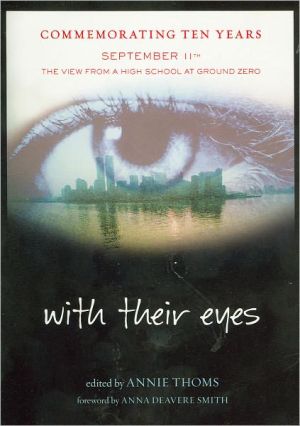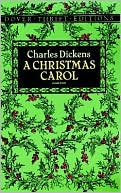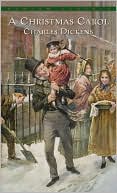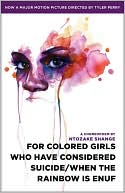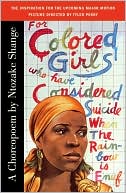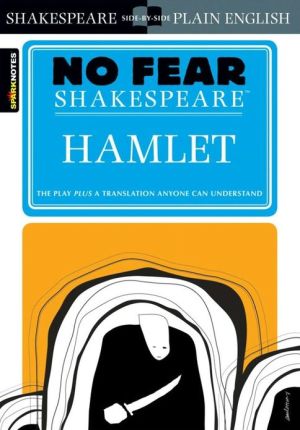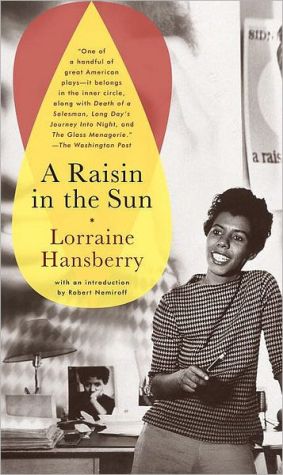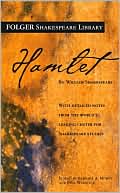With Their Eyes: September 11th -- The View from a High School at Ground Zero
I could have died that day.\ September 11, 2001\ Monologues from Stuyvesant High School\ Tuesday, September 11, started off like any other day at Stuyvesant High School, located only a few blocks away from the World Trade Center. The semester was just beginning, and the students, faculty, and staff were ready to begin a new year.\ But within a few hours on that Tuesday morning, they would all share an experience that transformed their lives.\ Now, on the tenth anniversary of September 11th,...
Search in google:
September 11, 2001Monologues from Stuyvesant High SchoolTuesday, September 11, seemed like any other day at Stuyvesant High School, only a few blocks away from the World Trade Center. The semester was just beginning, and the students, faculty, and staff were ready to start a new year.Within a few hours that Tuesday morning, they would experience an event that transformed all their lives completely.Here, in their own words, are the firsthand stories of a day none of us will ever forget.Publishers WeeklyThoms, an English teacher at Stuyvesant High School, located four blocks from the site of the World Trade Center, spearheaded a school production last February based on 10 students' recorded interviews (with classmates, faculty and staff members). The students converted the transcripts into "poem-monologues," which they presented and the text of which appears here. In Thoms's introduction, she notes that the goal was "to capture the ways individual people express themselves in speech," and, indeed, the collective impression is one of a group therapy session that may well provide some healing for teen readers still struggling with the event's aftermath. Many of the monologues (at times laced with "um" and "like") probably work better in a dramatization; on the page, the narratives at times falter and a few repeat similar themes. The poignant "Precious Cargo," for instance, begins with a photograph of a student performing as a pregnant English teacher, and her words of protectiveness about both her unborn child and her students read well on the page, but would likely be even more moving onstage. Still, the emotional rhythms of the volume take on a credible ebb and flow. A welcome dash of humor comes through in a freshman's contention that the students' relocation to Brooklyn Tech (while their school functioned as a triage center) put everyone on equal footing ("Everybody was like/ `Where the hell are my classes?'/ so it was kinda like everybody was a freshman"). In the closing entry, perhaps the most smoothly structured in the volume, the school theater manager recalls returning to a newly reopened Stuyvesant to find the flag missing from the stage. Later, he "came across a picture/ of firemen/ installing a flag/ on the mast of the World Trade Center/ and I looked at the picture and my jaw dropped./ It was our flag." Readers willing to overlook less relevant and revealing segments will find a number of moving moments here. Ages 13-up. (Sept.) Copyright 2002 Cahners Business Information.
Chronology of Events\ tuesday, september 11, 2001\ 8:48 a.m. -- The first plane hits the north tower. Many at Stuyvesant hear the bang, and feel the school tremble.\ 8:50 - 9:02 a.m. -- Principal Stanley Teitel contacts the school superintendent's office, and determines it is safest to keep all students inside the building. Over the loudspeaker, an administration official informs the Stuyvesant community that a "small plane" has hit the World Trade Center.\ 9:03 a.m. -- The second plane hits the south tower. Many students, faculty, and staff see the collision, and watch the ensuing fire from the building's south-facing windows. Some turn on the televisions which hang in each Stuyvesant classroom. Phone communications from the building are jammed.\ 9:04 - 9:49 a.m. -- FBI and Secret Service agents enter the building, and begin to set up Stuyvesant as a command post and triage center. Teitel asks the agent in charge, "What are the chances of those towers coming down?" The agent responds, "No chance." Teitel announces over the loudspeaker that all students are to stay in the building. At the bell at 9:25, students move to their next class.\ 9:50 a.m. -- The south tower collapses. Stuyvesant shakes. Lights flicker, and television pictures turn to static -- the television antenna on top of the World Trade Center is gone.\ 9:51 - 10:29 a.m. -- Assistant Principal of Student Services Eugene Blaufarb announces over the loudspeaker that students should report to their homerooms. After a brief administrative meeting, he announces that Stuyvesant students and faculty are to evacuate thebuilding, exiting through two doors on the north, sheltered side only. Students are joined on their walk uptown by pedestrians fleeing lower Manhattan, many covered head-to-toe with thick white dust.\ The teachers and paraprofessionals working at P.S. 721, the special education school housed in rooms on the top three floors of Stuyvesant, begin to evacuate their students from the school. Most of them are wheelchair-bound. They take the freight elevators down to the first floor and begin their journey to a safe school uptown.\ 10:30 a.m. -- The north tower collapses, sending a wave of dust up from the World Trade Center and over Stuyvesant. The evacuation continues, as over 3,200 members of the Stuyvesant community funnel through the two doors.\ 10:31 a.m. and later -- Stuyvesant's theater and gyms continue to be used as a command center. All students and faculty have safely vacated the building. Many staff members, including school safety officers and custodians, remain to help the rescue workers and keep the building running.\ Public transportation has been suspended. Students and faculty walk uptown in small groups, splitting off from each other to go to their homes or the homes of friends nearby.\ wednesday, september 12\ All New York City schools are closed.\ thursday, september 13 -- wednesday, september 19\ As other New York City schools reopen, Stuyvesant and several other schools in the area remain closed. Stuyvesant's building continues to be used as a command center and staging area for the World Trade Center rescue effort. Thousands of tons of supplies are stored there, and rescue workers are fed, clothed, and housed. Classrooms are filled with clothing and food; cots line the hallways. Many members of the Stuyvesant staff work round-the-clock shifts to aid the rescue workers.\ Stuyvesant students, living all over the five boroughs of New York, communicate with each other by e-mail. On internet message boards, they tell each other their stories and share information.\ On September 16th, the first Sunday after the attacks, over four hundred Stuyvesant students gather in Greenwich Village to paint two eighty-foot murals: a tree of life growing out of rubble, and a banner honoring New York's heroes.\ Stuyvesant's administration and Parents' Association negotiate with the Board of Education, trying to find an alternate site at which to reopen Stuyvesant. Martin Luther King, Jr. High School, in uptown Manhattan, is proposed as a possibility, but ultimately Brooklyn Technical High School is chosen.\ thursday, september 20\ Stuyvesant reopens on a split schedule at Brooklyn Technical High School. At the opening-day assembly in Brooklyn Tech's auditorium, four times larger than the theater at Stuyvesant, there is 98% student attendance. The Stuyvesant community listens to speeches by Principal Stanley Teitel, Student Union (SU) President Jukay Hsu, and officials from the Board of Education.\ friday, september 21 -- friday, october 5\ Stuyvesant and Brooklyn Tech share one building. Brooklyn Tech's 4,000 students attend class from 7:30 a.m. to 1:15 p.m. Stuyvesant's 3,030 students attend class from 1:30 p.m. to 6:30 p.m., in twenty-six-minute periods.\ Stuyvesant and Brooklyn Tech are academic rivals, and a certain amount of tension exists between the two student populations. Stuyvesant students are at a disadvantage in the sprawling floor plan of Brooklyn Tech, where rooms are referred to by floor, compass direction, and room number (1E22, 3W44). Many Stuy students find themselves bewildered by separate up and down staircases.\ In English classes, Stuyvesant students answer thousands of letters written by students in schools across the country and as far away as Japan.\ On October 2, The Spectator, Stuyvesant's school newspaper, put out a special full-color, magazine-style issue focusing on the events of September 11th. The student-written articles and student photos receive praise and media attention across the city. In November, the issue is reprinted as an insert in The New York Times.\ Negotiations over the date of the reopening of Stuyvesant's building continue. Officials in charge of the rescue operation at ground zero leave the building, which is professionally cleaned to remove the dust from the towers' collapse and the rescue effort...\ with their eyes. Copyright © by Annie Thoms. Reprinted by permission of HarperCollins Publishers, Inc. All rights reserved. Available now wherever books are sold.
ForewordxiAcknowledgmentsxxiiiIntroduction1Chronology of Events11Act 1Overture21Piece of My Home--11ya Feldsherov31Bag Man--Max Willens41Golden State--Renee Levine47Big Kids--Aleiya Gafar55Special--Matt Polazzo65Turning Point--Anonymous Female Dining Hall Worker73This Time--Renee Levine79Precious Cargo--Katherine Fletcher87Facing North--Hudson Williams-Eynon95Slide Show--Juan Carlos Lopez99Everybody was a Freshman--Katie Berringer109Heartless--Kevin Zhang115You Need Hope--Hector Perez and Haydee Sanabria119A Very Intriguing Train--Eddie Kalletta127Act 2Things Below, Things Above--Mira Rapp-Hooper133Safety Net--Max Willens139Tender Lovin'--Owen Cornwall155Wake-Up Call--Eddie Kalletta159Powerless-Jukay Hsu165I Live My Life Here--Anonymous Male Custodian173What Matters--Tony Qian187We Run Dis School--Alejandro Torres Hernandez195Amazingly Resilient--Jennifer Suri199Fearing for Your Safety--Mohammad Haque209Missing Wings--Kerneth Levigion217Original Production Notes224Notes on Staging226
\ From Barnes & NobleThe Barnes & Noble Review\ New York City's Stuyvesant High School stands within sight of the World Trade Center, and on September 11, 2001, it quickly became the concern of many Americans and world citizens. As a window into this school's experiences surrounding that tragic day, a group of creative acting students from Stuyvesant have assembled this stunning collection of monologues -- originally performed on stage, now in print form -- to unite the memories and emotions of its students and employees. \ Under the direction of English teacher Annie Thoms, who provided the helpful introduction to this book, the student members of the Stuyvesant Theater Company began this project about 9/11, "in which Stuyvesant students were able to tell their own stories, and the stories of others in our community." The actors talked with fellow students, teachers, assistant principals, dining hall workers, and custodians, taking careful note of each person's physical mannerisms and verbal patterns. After all the pieces were assembled and a stage was created, the actors performed "with their eyes" in February 2002 -- each student played the person he or she had interviewed, surmounting differences in age, ethnicity, or gender -- to audiences who responded with standing ovations. This book, then, is the series of monologues the students performed, along with photos from the production, a foreword from actress and playwright Anna Deavere Smith, a chronology of Stuyvesant High School events on 9/11, and extra notes on the production and staging.\ Both moving and engrossing, With Their Eyes will touch all readers looking to connect with their own memories about 9/11 or seeking realistic insight into the minds of students who experienced that day firsthand. Young readers will be motivated to document their own stories or feelings about September 11th, while parents and teachers can launch meaningful discussions at home, at book groups, or in the classroom. A powerful work that steers clear of "being cheesy or maudlin," this impressive work captures voices that teach and inspire. Matt Warner\ \ \ \ \ \ Booklist"The speakers reveal their emotions with a painful honesty that’s profound, and the startling immediacy of the words gives these pieces even more impact. An obvious choice for reader’s theater and for use across the curriculum; its deeply affecting contents will also make compelling personal-interest reading."\ \ \ Publishers WeeklyThoms, an English teacher at Stuyvesant High School, located four blocks from the site of the World Trade Center, spearheaded a school production last February based on 10 students' recorded interviews (with classmates, faculty and staff members). The students converted the transcripts into "poem-monologues," which they presented and the text of which appears here. In Thoms's introduction, she notes that the goal was "to capture the ways individual people express themselves in speech," and, indeed, the collective impression is one of a group therapy session that may well provide some healing for teen readers still struggling with the event's aftermath. Many of the monologues (at times laced with "um" and "like") probably work better in a dramatization; on the page, the narratives at times falter and a few repeat similar themes. The poignant "Precious Cargo," for instance, begins with a photograph of a student performing as a pregnant English teacher, and her words of protectiveness about both her unborn child and her students read well on the page, but would likely be even more moving onstage. Still, the emotional rhythms of the volume take on a credible ebb and flow. A welcome dash of humor comes through in a freshman's contention that the students' relocation to Brooklyn Tech (while their school functioned as a triage center) put everyone on equal footing ("Everybody was like/ `Where the hell are my classes?'/ so it was kinda like everybody was a freshman"). In the closing entry, perhaps the most smoothly structured in the volume, the school theater manager recalls returning to a newly reopened Stuyvesant to find the flag missing from the stage. Later, he "came across a picture/ of firemen/ installing a flag/ on the mast of the World Trade Center/ and I looked at the picture and my jaw dropped./ It was our flag." Readers willing to overlook less relevant and revealing segments will find a number of moving moments here. Ages 13-up. (Sept.) Copyright 2002 Cahners Business Information.\ \ \ \ \ From The CriticsNew York City's Stuyvesant High School was on the front lines the morning of September 11, 2001. As faculty and students watched, the nearby Twin Towers tumbled into dust. Relocated while their school was used for the rescue mission, the students in Annie Thoms's English class tried to decipher the event's effect on their school community. Fitted with tape recorders, the students sought out students, faculty and staff and interviewed them about their experiences on and after September 11. They transcribed each interview, selecting twenty-five to turn into a two-act play, with students portraying their interviewees through dress, gesture and speech patterns. The play was performed on February 8 and 9, 2002, at Stuyvesant High. Thoms's students have created a unique art form, part oral history, part drama, that depicts the wide range of emotions and reactions experienced by those in the inner rings of ground zero. This text can be a resource for producing the play, but also for other teachers to use in constructing a multigenre project. Powerful and poignant, With Their Eyes is testament to the power of writing. 2002, HarperTempest, 228 pp., \ — Michele Winship\ \ \ \ \ School Library JournalGr 7 Up-The terrorist attacks on September 11, 2001 have changed the lives of all Americans. The students, faculty, and staff of Stuyvesant High School, located four blocks from Ground Zero, responded creatively with a unique work of reader's theater. In with their eyes, student actors transcribed monologues culled from interviews with their fellow classmates, teachers, custodians, and cafeteria workers. The pieces describe the pain of watching people jump to their deaths from office windows, the terror of being separated from their families, the lingering aftereffects of being temporarily housed in a different school, and the post-traumatic stress that nearly paralyzed all 3200 students. The monologues echo the individuals' everyday speech, including the "ums," "likes," and "you knows," which, while sometimes jarring to read, make them dramatically immediate and realistic when performed. This unique book rings with authenticity and resonates with power; it can be used in the curriculum or as an independent piece of theatrical art. Pair it with Michael Cart's excellent 911: The Book of Help (Cricket, 2002), Mitch Frank's Understanding September 11th: Answering Questions about the Attacks on America (Viking, 2002), or Mitchel Levitas's A Nation Challenged: A Visual History of 9/11 and Its Aftermath: Young Reader's Edition (Scholastic, 2002).-Susan Riley, Mount Kisco Public Library, NY Copyright 2003 Cahners Business Information.\ \
